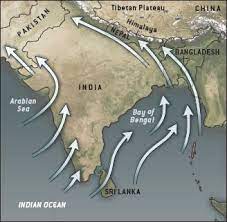- Books Name
- Learn with me Social Science Book
- Publication
- Learn with me publication
- Course
- CBSE Class 9
- Subject
- Social Science
Distribution of Rainfall
- Owing to the nature of monsoons, the annual rainfall is highly variable from year to year.
- Areas of high rainfall are liable to be affected by floods while areas of low rainfall are drought prone.
The Seasons
- Four main seasons can be identified in India — the cold weather season, the hot weather season, the advancing monsoon and the retreating monsoon with some regional variations.
- In the cold weather season the northeast trade winds prevail over India.
- Days are warm and nights are cold.
- Frost is common in the north and the higher slopes of the Himalayas experience snowfall.
- The summer months experience rising temperature and falling air pressure in the northern parts of the country.
- A striking feature of the hot weather season are strong, gusty, hot, dry winds blowing during the day over the north and northwestern India called loo.
- In the advancing monsoon, i.e. the rainy season, the north-western region of the country receives the maximum rainfall.
- The dust storms in northern India are common.
- The localised thunderstorms, associated with violent winds, torrential downpours, often accompanied by hail. In west Bengal they are known as ‘Kaal Baisakhi’.
- From June onwards the monsoon occupies most of the Indian Peninsula and central part within a month.
- Monsoon has ‘breaks’ in rainfall, thus it has wet and dry spells.
- The alternation of dry and wet spells vary in intensity, frequency and duration causing heavy floods in one part and droughts in the others.
- By the beginning of October the monsoon withdraws from Northern plains.
- The conditions of high temperature and humidity, the weather becomes rather oppressive during the day and is called as October heat.
- Rainfall in India ranges from 400 cm in western coast and northeastern India to 60 cm in Western Rajasthan and adjoining area.

Monsoon as a Unifying Bond
- The dependence of farmers on rain, a change in seasonal cycle, variance in temperature, the needs of humans, plants and animals, festival dates etc., all depend on monsoon in India. In this way monsoon is a unifying bond for Indians.

 Learn with me publication
Learn with me publication
